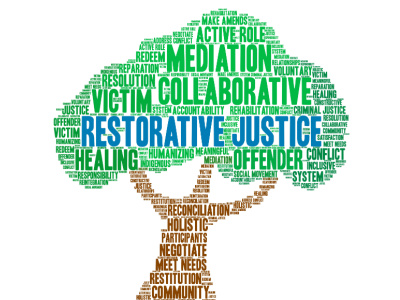 In recent years, there has been a growing interest in alternative approaches to criminal justice. One such approach is restorative justice, which focuses on repairing the harm caused by crimes through dialogue, negotiation, and reconciliation between victims, offenders, and the community. While traditional punitive measures aim to punish offenders and deter future crimes, restorative justice seeks to address the underlying issues that lead people to commit criminal offenses.
In recent years, there has been a growing interest in alternative approaches to criminal justice. One such approach is restorative justice, which focuses on repairing the harm caused by crimes through dialogue, negotiation, and reconciliation between victims, offenders, and the community. While traditional punitive measures aim to punish offenders and deter future crimes, restorative justice seeks to address the underlying issues that lead people to commit criminal offenses.
Restorative justice may help address the ongoing crisis of mass incarceration in the United States. While many criminal cases focus on punishing alleged offenders, this has resulted in lengthy prison sentences for many people, as well as difficulties for inmates who struggle to reintegrate into their communities after serving their sentences and being released from prison. An attorney who provides representation for criminal defendants and convicts can provide guidance on the options for restorative justice and the steps that can be taken to ensure that prisoners’ rights are protected.
Restorative justice is guided by several key principles:
Inclusion: All stakeholders affected by a crime are given the opportunity to participate in the restorative process.
Accountability: Offenders take responsibility for their actions and work towards making amends.
Reparation: The focus is on repairing the harm caused by the offense rather than imposing punishment.
Community engagement: Communities play an active role in addressing crime, building support systems, and preventing future offenses.
Rather than being purely retributive or punitive, restorative justice aims at achieving broader societal benefits. Some potential advantages include:
Promoting healing: Through open communication and shared understanding, both victims and offenders may find healing and closure. Victims have an opportunity to express their feelings while getting answers to their questions, and offenders can acknowledge the impact of their actions.
Reducing recidivism: Restorative justice programs often show lower recidivism rates compared to traditional punitive measures. By addressing the root causes of criminal behavior and encouraging accountability, criminal convicts may be less likely to engage in future criminal activities.
Empowering victims: This approach emphasizes victims' rights by giving them a voice in the process. It allows them to actively participate in decision-making regarding restitution and resolution, granting them a sense of empowerment.
Promoting community safety: By involving communities in restorative processes, these initiatives aim to foster social cohesion and reduce crime rates. When community members actively engage with offenders during their rehabilitation, they take ownership of finding solutions that can create safer neighborhoods.
In many jurisdictions across the United States, restorative justice practices are used as complementary or alternative processes within the existing criminal justice system. These programs may be used in cases where both victims and offenders express a willingness to participate
While restorative justice programs often focus on non-violent offenses, some recent cases have demonstrated their effectiveness even in cases involving murder or other violent crimes. In a recent case in North Carolina, a young man who killed his father during an argument was able to avoid a life sentence by working with his family members through a process of reconciliation and accountability. By following conditions set by family members who were affected by the crime, the young man has been able to be released from prison and take steps to repair the harm caused, maintain important family relationships, and move forward into a successful future.
In Connecticut, restorative justice programs may be available for juvenile offenders. These programs allow minors who are involved in the juvenile justice system to take accountability for their actions, understand the ways others have been affected, work together with victims and other community members to address the harm caused, and prevent future offenses. While some have called these programs “soft on crime,” criminal justice advocates have noted that the rates of juvenile crime have not increased since restorative justice programs have been implemented, and they have also highlighted the positive effects that restorative justice can have on offenders, victims, and the community as a whole.
Restorative justice offers an alternative approach to the traditional punitive measures used by the criminal justice system. By focusing on repairing harm, promoting healing, and involving all stakeholders in the process, restorative justice aims to address the underlying issues that can lead people to commit crimes
At Woolf Law Firm, LLC, we work to help people who have been charged with criminal offenses determine their best options for defense. We can help determine whether restorative justice options may be available to reduce a sentence, encourage rehabilitation, and minimize the effects of a criminal conviction. To learn how our Connecticut criminal defense attorney can assist with your case, contact us at 860-290-8690 and set up a free consultation.
 50 Founders Plaza
50 Founders Plaza

